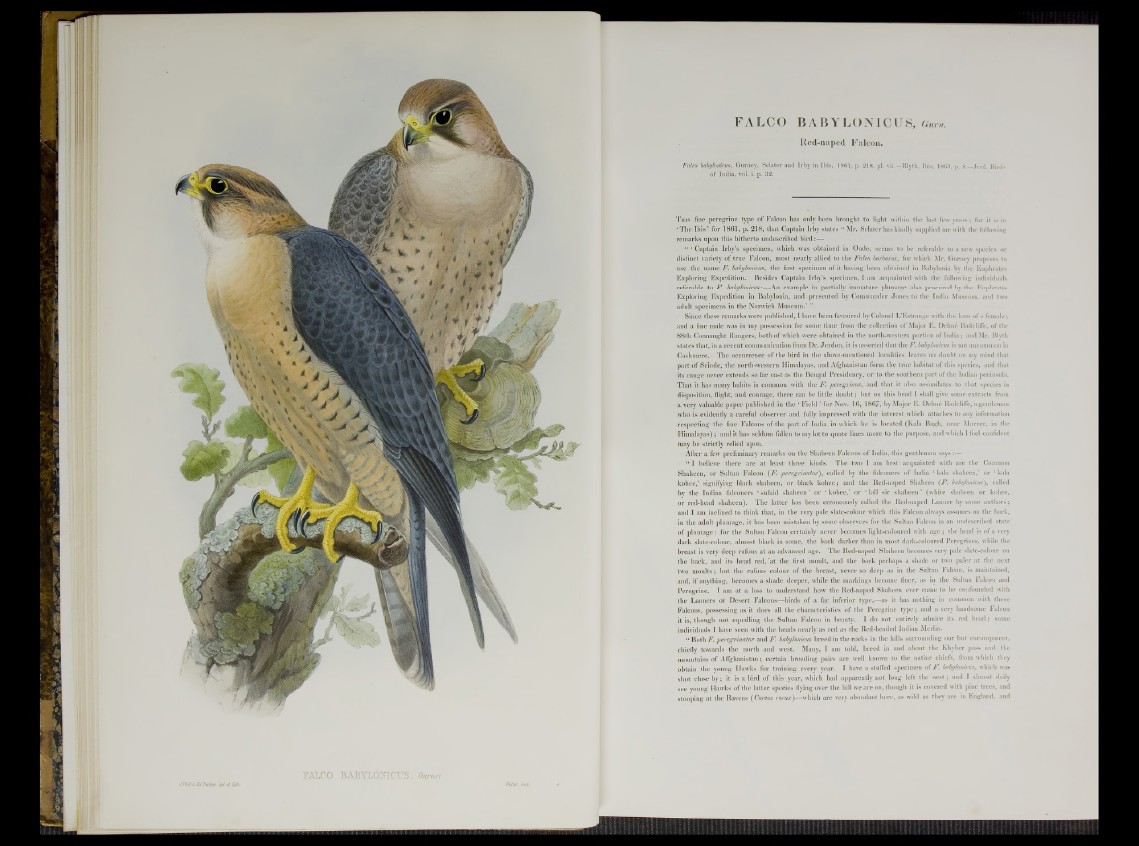
J. Wolf &, HC.Ruhter, deb e t Uthe.
TTALCO BABTLOXICUS, Gunter
Waller, Imp.
FALCO BABYLONICUS, Gum.
Red-naped Falcon.
Falco babylonicus, Gurney, Sclater and Irby in Ibis, 1861, p. 218, pi. vii. —Blytli, Ibis, 1863, p. 8. Jerd. Birds
of India, vol. i. p. 32.
T his fine peregrine type of Falcon has only been brought to light within the last few years; for it is in
‘The Ibis’ for 1861, p. 218, that Captain Irby states “ Mr. Sclater has kindly supplied me with the following
remarks upon this hitherto undescribed bird :—
“ ‘ Captain Irby’s specimen, which was obtained in Oude, seems to be referable to a new species or
distinct variety of true Falcon, most nearly allied to the Falco barbarus, for which Mr. Gurney proposes to
use the name F. babylonicus, the first specimen of it having been obtained in Babylonia by the Euphrates
Exploring Expedition. Besides Captain Irby’s specimen, I am acquainted with the following individuals
referable to F. babylonicus:—An example in partially immature plumage also procured by the Euphrates
Exploring Expedition in Babylonia, and presented by Commander Jones to the India Museum, and two
adult specimens in the Norwich Museum.’ ’’
Since these remarks were published, I have been favoured by Colonel L’Estrange with the loan of a female;
and a fine male was in my possession for some time from the collection of Major E. Delme Radcliffe, of the
88th Connaught Bangers, both of which were obtained in the north-western portion of India; and Mr. Blyth
states that, in a recent communication from Dr. Jerdon, it is asserted that the F. babylonicus is not uncommon in
Cashmere. The occurrence of the bird in the above-mentioned localities leaves no doubt on my mind that
part of Scinde, the north-western Himalayas, and Afghanistan form the true habitat of this species, and that
its range never extends so far east as the Bengal Presidency, or to the southern part of the Indian peninsula.
That it has many habits in common with the F. peregrinus, and that it also assimilates to that species in
disposition, flight, and courage, there can be little doubt; but on this head I shall give some extracts from
a very valuable paper published in the ‘ Field ’ for Nov. 16, 1867, by Major E. Delme Radcliffe, a gentleman
who is evidently a careful observer and fully impressed with the interest which attaches to any information
respecting the fine Falcons of the part of India in which he is located (Kala Bagh, near Murree, in the
Himalayas); and it has seldom fallen to my lot to quote lines more to the purpose, and which I feel confident
may be strictly relied upon.
After a few preliminary remarks oh the Shaheen Falcons of India, this gentleman says:—? .
“ I believe there are at least' three kinds. The two 1 am best- acquainted with are the Common
Shaheen, or Sultan Falcon (F. peregrmator), called by the falconers of India ‘ kala shaheen,’ or ‘kala
kohee,’ signifying black shaheen, or black kohee; and the Red-naped Shaheen (F. babylonicus), called
by the Indian falconers ‘ sufaid shaheen ’ or ‘ kohee,’ or ‘ lall sir shaheen ’ (white shaheen dr kohee,
or red-head shaheen). The latter has been erroneously called the Red-naped Lanner by some authors;
and I am inclined to think that, in the very pale slate-colour which this Falcon always assumes on the back,
in the adult plumage, it has been mistaken by some observers for the Sultan Falcon in an undescribed state
of plumage: for the Sultan Falcon certainly never becomes light-coloured with age ; the head is of a very
dark slate-colour, almost black in some, the back darker than in most dark-coloured Peregrines, while the
breast is very deep rufous at an advanced age. The Red-naped Shaheen becomes very pale slate-colour on
the back, and its head red, "at the first moult, and the back perhaps a shade or two paler at the next
two moults; but the rufous colour of the breast, never so deep as in the Sultan Falcon, is maintained,
and, if anything, becomes a shade deeper, while the markings become finer, as in the Sultan Falcon and
Peregrine. I am at a loss to understand how the Red-naped Shaheen ever came to be confounded with
the Lanners or Desert Falcons—birds of a far inferior type,—as it has nothing in common with these
Falcons, possessing as it does all the characteristics of the Peregrine type; and a very handsome Falcon
it is, though not equalling the Sultan Falcon in beauty. I do not entirely admire its red head; some
individuals I have seen with the heads nearly as red as the Red-headed Indian Merlin.
“ Both F. peregrinator and F. babylonicus breed in the rocks in the hills surrounding our hut encampment,
chiefly towards the north and west. Many, I am told, breed in and about the Khyber pass and the
mountains of Affghanistan; certain breeding pairs are well known to the native chiefs, from which they
obtain the young Hawks for training every year. I have a stuffed specimen of F. babylonicus, which was
shot close by; it is a bird of this year, which had apparently not long left the nest; and I almost daily
see young Hawks of the latter species flying over the hill we are on, though it is covered with pine trees, and
stooping at the Ravens ( Corpus corax)—which are very abundant here, as wild as they are in England, and